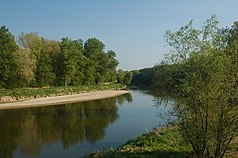Záhorie Protected Landscape Area
| Protected landscape area Záhorie Chránená krajinná oblasť Záhorie |
||
|---|---|---|
| The March (Slovak Morava ) between Moravský Svätý Ján and Hohenau an der March (A) | ||
|
|
||
| Location: | Bratislavský , Trnavský , Slovakia | |
| Next city: | Malacky , Stupava , Šaštín-Stráže | |
| Surface: | 275.22 km² | |
| Founding: | November 9, 1988 | |
| Address: | Správa CHKO Záhorie Vajanského 17 901 01 Malacky |
|
The conservation area Záhorie ( Slovak chráněná Krajinná oblasť Záhorie ) is a conservation area in the far west of Slovakia , in the traditional, non-administrative landscape Záhorie . It is the first large, extensive nature reserve in a lowland in Slovakia. The 275.22 km² area is located in the political districts of Bratislavský kraj ( Okres Malacky ) and Trnavský kraj ( Okres Senica ) and consists of two quite different parts: one along the border river March and one in the lowland Borská nížina .
The seat of the administration is in Malacky .
Geography, flora and fauna
In the following, the separated parts are treated separately. Geomorphologically, both are part of the Záhorská nížina , but differ from the point of view of nature.
Western part along the March
The western part occupies a strip of land on the left bank of the March (border with Austria ), between the villages of Kúty in the north, just upstream of the mouth of the Thaya , and Stupava in the south, just before the city limits of Bratislava . The municipalities Suchohrad , Záhorská Ves and Vysoká pri Morave are within the protected landscape area. The landscape consists of alluvial forests and floodplains, complemented by numerous canals, small lakes and other wetlands. The largest raft meadows in Slovakia are located here. Since the Iron Curtain ran along the March between 1948 and 1989 , large areas along the then border between Czechoslovakia and Austria were inaccessible or difficult to access. Thus, large parts of it are still preserved in a state similar to that of a jungle .
This variety of biotopes is of course also reflected in the diverse flora and fauna. So far, more than 700 species of vascular plants are known to be found in the meadows . Characteristic is a large occurrence of clematis (type Clematis integrifolia ). For example, black poplar or narrow-leaved ash grow from trees here . The area along the March is important for various species of migratory birds . There are also numerous species of crustaceans, molluscs, amphibians and fish. The European beaver , which spread from Austria in the 1980s after the species was exterminated in the past, is a kind of “symbol” for the landscape protection area .
Northeast part in the Borská nížina
The north-eastern part lies between the municipalities of Závod , Borský Svätý Jur , Šaštín-Stráže and Lakšárska Nová Ves and borders the Záhorie military area in the east . The area is formed by the blown sand and sand dunes that were created in the course of the Aeolian transport . So it is a unique phenomenon in Slovakia. Accordingly, in contrast to the March areas, the region is more dry and has a thin river system, as a large part of the precipitation "disappears" into the subsurface. In order to stop the natural drifting of the sand, pine trees have been planted here in large areas since the 17th century , which also give the geomorphological lowland Borská nížina its name. Because of the special soil conditions, only a small number of tree species grow here, such as B. In addition to pines, there are also oaks , which also use symbiosis with mushrooms. Ant lions and hoopoes can be found in the warm and dry areas . The pine forests provide a good nutritional basis for goat milkers , woodlarks and bats.
Special nature protection
- Národné prírodné rezervácie (NPR, National Nature Reserves)
- Abrod (92.37 ha, since 1964)
- Červený rybník (118.91 ha, 1966)
- Dolný les (186.26 ha, 1981)
- Horný les (543.02 ha, 1981)
- Zelienka (82.52 ha, 1980)
- Prírodné rezervácie (PR, nature reserves)
- Bogdalický vrch (33.2 ha, 1993)
- Šmolzie (45.59 ha, 1993)
Source:
literature
- Ján Lacika, Kliment Ondrejka: Prírodné Krásy Slovenska - Chránené krajinné oblasti . Ed .: DAJAMA. 1st edition. Bratislava 2009, ISBN 978-80-89226-29-0 .
Individual evidence
- ↑ Bobor - opäť udomácnený druh v našej prírode , sazp.sk ( Memento of the original from June 29, 2007 in the Internet Archive ) Info: The archive link was inserted automatically and has not yet been checked. Please check the original and archive link according to the instructions and then remove this notice. , accessed August 25, 2011
- ↑ Štátny zoznam osobitne chránených častí prírody SR
Web links
- Landscape protection area Záhorie on slovakia.travel (German) ( Memento from September 26, 2012 in the Internet Archive )
- Záhorie Protected Landscape Area on sopsr.sk (Slovak)



